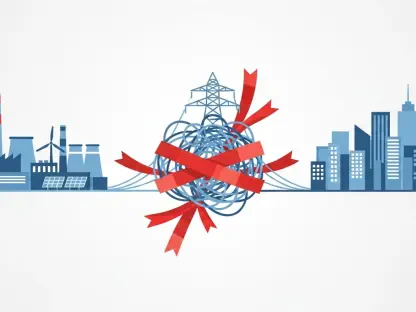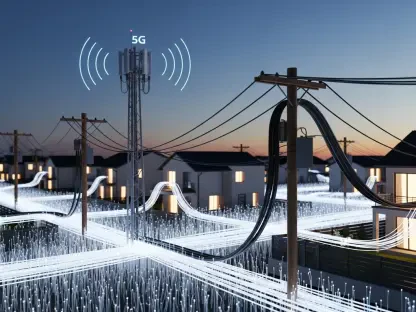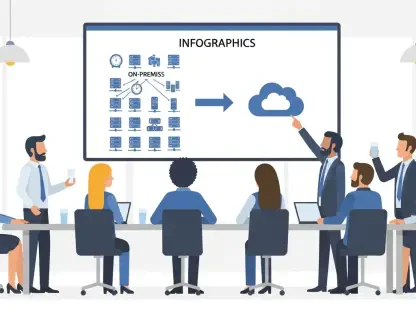Fixed version:
The global landscape of connectivity is on the brink of a monumental transformation, with 5G technology emerging as the linchpin of a hyper-connected future that promises to redefine how industries, governments, and societies function. Projections indicate that this dynamic market is set to soar to an astonishing $300 billion by 2035, fueled by a remarkable compound annual growth rate (CAGR) of 29.2% over the next decade starting from now. Far beyond just enhancing smartphone speeds, 5G offers ultra-low latency, unprecedented bandwidth, and the ability to link countless devices simultaneously, paving the way for groundbreaking advancements. This surge reflects a worldwide commitment to embracing fifth-generation wireless networks as the backbone of innovation, impacting everything from urban infrastructure to personal communication. As investments pour in from both public and private sectors, the momentum behind 5G signals a seismic shift in technological paradigms, setting the stage for a deeper exploration of its drivers, challenges, and transformative potential across diverse fields.
Unleashing the Power of 5G Growth
The meteoric rise of the 5G technology market is underpinned by an insatiable global demand for faster, more reliable connectivity that can keep pace with modern digital needs. Consumers are eager for seamless experiences in streaming high-definition content, while businesses require instantaneous data transfers to maintain competitive edges in fast-evolving sectors. This demand is amplified by the proliferation of smart devices and the Internet of Things (IoT), which rely heavily on robust network infrastructure to function effectively. Governments and corporations are funneling significant resources into 5G deployment, recognizing its role as a catalyst for economic growth and digital transformation. The urgency to adopt this technology has been further heightened by the need for resilient networks that can support remote work, virtual collaboration, and other digital services that have become integral to daily life. This convergence of consumer expectations and industrial requirements positions 5G as a cornerstone of future connectivity.
Beyond individual and corporate needs, the broader societal impact of 5G is becoming increasingly evident as it enables the integration of cutting-edge technologies like artificial intelligence (AI) and augmented reality (AR). These innovations depend on the low latency and high bandwidth that 5G uniquely provides, allowing for real-time analytics and immersive experiences that were previously unattainable. The technology’s capacity to connect millions of devices simultaneously also supports the expansion of smart cities, where everything from traffic systems to energy grids can be optimized for efficiency. As industries harness these capabilities, the economic ripple effects are profound, with job creation and new business models emerging in tandem with 5G adoption. This growth trajectory underscores the technology’s role not just as an upgrade to existing networks, but as a foundational shift that redefines operational possibilities across the globe.
Transforming Industries with Next-Gen Connectivity
The transformative power of 5G extends far beyond telecommunications, reshaping industries that are pivotal to modern economies with its ability to enable real-time data processing and connectivity. In healthcare, the technology is revolutionizing patient care through telemedicine platforms and remote surgical procedures, allowing doctors to diagnose and treat patients across vast distances with precision. This capability is particularly critical in underserved regions where access to specialized medical services is limited, thus bridging significant gaps in healthcare delivery. Meanwhile, the manufacturing sector benefits from 5G through the advent of smart factories, where automation and IoT devices streamline production processes with minimal human intervention. Such advancements reduce downtime and enhance productivity, setting new benchmarks for industrial efficiency. The widespread adoption of 5G in these fields illustrates its potential to create systemic change, fundamentally altering how essential services are delivered.
Another sector experiencing a profound shift due to 5G is automotive, where the technology is a key enabler of connected and autonomous vehicles that promise safer and more efficient transportation. By facilitating vehicle-to-everything (V2X) communication, 5G allows cars to interact with traffic systems, other vehicles, and pedestrians in real time, significantly reducing the likelihood of accidents. This innovation not only enhances road safety but also supports the development of smart urban mobility solutions that alleviate congestion in densely populated areas. Additionally, retail and entertainment industries are tapping into 5G to offer personalized customer experiences through AR applications and high-speed cloud gaming, engaging users in novel ways. These diverse applications across sectors highlight how 5G acts as a unifying force, driving innovation and efficiency in ways that transcend traditional industry boundaries, and laying the groundwork for a more interconnected global economy.
Leaders and Innovations Shaping the Market
At the forefront of the 5G revolution are industry giants such as Ericsson, Nokia, Huawei, Samsung Electronics, and Qualcomm, whose relentless pursuit of innovation is shaping the competitive landscape of this burgeoning market. These companies are not merely providers of technology but pioneers who are redefining connectivity through comprehensive solutions that span network infrastructure, device compatibility, and chipset development. Their investments in research and development ensure that 5G networks are not only faster but also more reliable and scalable to meet future demands. Strategic partnerships with other tech firms and telecom operators further amplify their impact, enabling the seamless integration of 5G into existing systems. This collaborative spirit is crucial for overcoming technical hurdles and accelerating the global rollout of advanced networks, positioning these players as indispensable drivers of market evolution.
Equally significant are the emerging trends in 5G technology that these leaders are championing, such as network slicing and edge computing, which offer customized connectivity solutions tailored to specific business needs. Network slicing allows operators to create virtual networks within a single physical infrastructure, optimizing performance for diverse applications ranging from industrial automation to consumer entertainment. Edge computing, on the other hand, brings data processing closer to the source, reducing latency and enhancing security—a critical feature for enterprises handling sensitive information. Additionally, the integration of AI with 5G networks is optimizing performance through predictive analytics and automated management, ensuring robustness even under heavy loads. These advancements reflect a broader industry shift toward flexibility and efficiency, demonstrating how innovation continues to push the boundaries of what 5G can achieve in practical, real-world scenarios.
Global Adoption and Regional Dynamics
The adoption of 5G technology varies significantly across regions, with North America leading the charge due to early investments and a strong focus on technological innovation, particularly in the United States. This region benefits from advanced infrastructure and substantial funding from major telecom operators, which have prioritized the rollout of both standalone and non-standalone 5G networks. Applications in smart cities, IoT ecosystems, and autonomous vehicle testing are thriving here, supported by a regulatory environment that encourages experimentation and deployment. The leadership position of North America is further solidified by its role as a hub for tech companies that are driving 5G-compatible solutions, making it a benchmark for other regions aiming to replicate similar success. This regional dominance highlights the importance of infrastructure readiness and investment scale in determining the pace of technology adoption.
Meanwhile, Asia-Pacific emerges as the fastest-growing region for 5G, propelled by countries like China, Japan, and South Korea, where high population density and widespread smartphone usage create fertile ground for network expansion. Industrial automation and government-led initiatives in digital transformation are key growth drivers, with significant resources allocated to spectrum allocation and infrastructure development. Europe follows with steady progress, particularly in nations such as Germany and the U.K., where public-private partnerships are fostering a robust 5G ecosystem. In contrast, regions like Latin America and the Middle East & Africa are in earlier stages of adoption, focusing on urban centers and industrial hubs to build connectivity foundations. Despite these disparities, the global trajectory points to an inevitable embrace of 5G as a critical component of economic and social progress, with each region adapting the technology to its unique challenges and opportunities.
Opportunities and Barriers on the Horizon
The 5G technology market brims with opportunities that promise to redefine various aspects of modern life, from urban planning to personal entertainment, as stakeholders explore its vast potential. Smart cities stand out as a prime beneficiary, with 5G enabling integrated systems for traffic management, energy conservation, and public safety through real-time data analytics. Industry 4.0 initiatives in manufacturing are also leveraging 5G to create fully automated production lines that enhance output while minimizing errors. Furthermore, the rise of digital entertainment, including cloud gaming and virtual reality experiences, is set to explode as 5G delivers the speed and capacity needed for immersive platforms. Enterprises are increasingly adopting private 5G networks to ensure secure, tailored connectivity, particularly in sectors like healthcare and retail where data sensitivity is paramount. These diverse applications underscore the technology’s role as a catalyst for innovation across multiple domains.
However, the path to widespread 5G adoption is not without significant challenges that require strategic solutions to maintain momentum. High infrastructure costs pose a formidable barrier, as deploying 5G networks demands substantial investments in equipment, spectrum, and skilled labor. Regulatory complexities and spectrum allocation issues further complicate the rollout, varying widely across regions and often slowing progress. Security concerns, particularly around data privacy and network vulnerabilities, remain a critical hurdle as the number of connected devices skyrockets. Despite these obstacles, the industry is responding with ingenuity, leveraging AI-driven optimizations and fostering collaborations between telecom operators and technology providers to address inefficiencies and enhance security protocols. This proactive approach signals a commitment to overcoming barriers, ensuring that the transformative promise of 5G becomes a tangible reality for all.
Reflecting on a Connected Legacy
Looking back, the journey of the 5G technology market unfolded as a testament to human ingenuity, having redefined connectivity with a projected valuation of $300 billion by 2035 and a staggering CAGR of 29.2% over the decade. Industries ranging from healthcare to automotive witnessed profound changes, as real-time data and ultra-low latency became integral to their operations. Global leaders and regional pioneers alike played pivotal roles in driving adoption, navigating a landscape marked by both innovation and formidable challenges. As the world became increasingly interconnected, the focus shifted toward sustaining this momentum through actionable strategies. Future considerations centered on balancing infrastructure investments with security enhancements, ensuring that 5G networks remained robust against emerging threats. Collaborative efforts between governments and private entities proved essential in addressing regulatory gaps and fostering equitable access across regions. The legacy of 5G ultimately rested on its ability to empower societies with smarter, more efficient solutions, urging stakeholders to prioritize scalability and inclusivity in the next phases of technological evolution.









